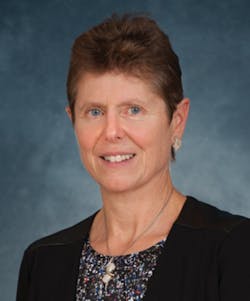Transforming biology into an engineering discipline
Chief Technology Officer and Senior Vice President
Agilent Technologies
“The vision is that at some point biology can be transformed into a pure engineering discipline,” said Dr. Darlene Solomon, chief technology officer and senior vice president of Agilent Technologies, at the closing session of the International Microwave Symposium May 21 in Phoenix.1 Her contention was that while the 20th century was the century of physics, the 21st century is the century of biology, adding, “The century of biology is good for engineering.”
Solomon’s position at Agilent, where she has been CTO since 2006, will help her drive engineering innovations in biology. Agilent addresses the life-sciences, diagnostics, and applied-chemistry markets after recently spinning off its electronics measurement business into Keysight Technologies.2
Addressing a meeting at IMS in 2009, before the Keysight spinoff, Solomon quoted Maxwell to the effect that “to measure is to know.” When asked in a phone interview shortly before IMS 2015 if that maxim continues to apply, she said measurement is becoming increasingly important in biology. Over the last 20 years, she said, biology has transitioned from a qualitative descriptive science to an increasingly quantitative one in which the measurement side is becoming far more central. “There are many ways in which principles of engineering apply to biology as it becomes more quantitative and at some point perhaps even well-enough understood to be modeled and predicted,” she said.
Solomon said that when she began overseeing research and development back in 2003, molecular analysis represented less than 20% of Agilent’s business. That percentage has steadily increased to the point where both the molecular and electronic measurement businesses were ready to stand on their own, and it made sense to separate the two to let each organization focus on its own growth opportunities. Nevertheless, Solomon said, “I enjoyed the breadth of the old Agilent. But the new Agilent is where my expertise is centered, and I could not be more excited to help advance game-changing technologies we are developing internally and together with external academic and industrial partners.”
Elaborating on the transition from the century of physics to the century of biology, she said physics continues to advance significantly, but the rate of change in biology is really impacting our world. Further, she commented on touchpoints where biology and electronics might converge. “My experience in industry and at Agilent is that we see many of the most impactful innovations happening at the interfaces across disciplines,” she said.
At least one technical session at IMS 2015 supported this view. The session “Cellular-Level Microwave Measurements” reviewed advances in cellular characterization via interaction with RF/microwave fields.
Solomon cited advances in computational capabilities and the ability to understand how cells work at the molecular level. One takeaway for the electrical engineer, she said, is that there are important ways cells communicate electrically, and there are electrical ways to probe the cell. “Think of engineering biology,” she said. “Do that in an engineering-based mindset: reprogram the cell through the design of DNA changes, build the modified cell, and test it and analyze it.”
The physics advances of the last century were driven in part by the invention of the transistor and the scaling of transistors in accordance with Moore’s Law. When asked if there were similar enabling breakthroughs in biology this century, she cited the ability to exploit DNA. “Polymerase chain reaction technology goes back a while,” she said, “but there are incredible additional advances in our ability to harness the power of DNA. Sequencing DNA is equivalent to reading DNA and has become fast and relatively inexpensive, but now we have moved beyond that, and it’s also possible to very effectively synthesize DNA, which is the equivalent of writing DNA.”
She continued, “Additional fundamental advancements have been in systems/integrated biology and tools to understand biological pathways—both DNA and systems-biology advances are important Agilent platform solutions. These capabilities are enabling completely new paradigms in genomics and cellular understanding and control, much as the invention of the transistor.”
When asked about current innovations at Agilent, she cited pushing the capabilities of mass spectrometry, gas phase analysis, and elemental analysis for environmental and food-safety applications. And work in protein analysis and metabolomics, she said, complements work in genomics. “Metabolites are downstream from genomics and more indicative of what going on inside our cells and tissues.” And, she said, “Agilent will continue to push what’s possible in the chemistry and analysis of nucleic acids.”
Solomon received her bachelor’s degree in chemistry from Stanford University and her doctorate in bioinorganic chemistry from MIT. She serves on multiple academic and government advisory and review boards, including the National Academies’ board on chemical sciences and technology, the visiting committee on advanced technology of the National Institutes of Standards and Technology, the Stanford University Interdisciplinary Biosciences Advisory Council, University of California-Berkeley’s College of Engineering, and the Bay Area Science and Innovation Consortium.
She was inducted into the Women in Technology International’s Hall of Fame in 2001 and received the YWCA Tribute to Women and Industry Award in 2004. In addition, she was named to Diversity Journal’s “Women Worth Watching” in 2007 as well as The Corporate Board Member’s “50 Top Women in Technology” in 2008.
References
Nelson, R., “IMS 2015 hints at the century of biology with keynote and technical session,” EE-Evaluation Engineering Online, May 24, 2015.
Nelson, R., “Keysight touts 100% focus on electronic measurement,” EE-Evaluation Engineering, May 2015, p. 28.


